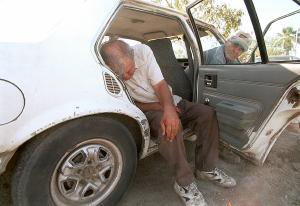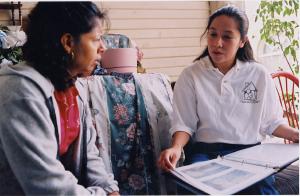|
Issue Date: September 26, 2003
Health promoters program prepares community leaders for jobs in health care By ARTHUR JONES Public health worker Nancy Halpern Ibrahim headed off to the West Bank and then Damascus, Syria, with her husband and children more than a decade ago to create community health and women’s economic development programs. She didn’t think she’d return with a health promotion program for Los Angeles. Yet Ibrahim, with a University of California Los Angeles master’s degree in public health, had no sooner stepped back into Los Angeles in 1995 than a friend recruited her to direct community health programs for Esperanza Housing (NCR, Jan. 18, 2002).
“It was the heyday of Bill and Hil,” said Ibrahim, referring to the national health care push attempted by the Clinton White House. In Los Angeles, the community Local Initiatives Support Corporation -- encouraged by what it foresaw as a health-initiatives national priority ahead -- provided seed money to four local agencies to address access to health care. Esperanza Housing was one, the only one that did not to push the money into opening “yet another primary care clinic,” said Ibrahim. Instead, under her tutelage, Esperanza Community Housing Corporation, a women’s collective, focused on job creation in the health care field. The collective’s director is energetic Sr. Diane Donaghue, a member of the Sisters of Social Service. And the promotores (health promoters) program came into being. What “our community was requesting beyond housing needs,” said Ibrahim, “were remunerative salaries that break the cycle of poverty -- the greatest health problem -- plus access to health services.” So Esperanza, “based on my work abroad,” said Ibrahim, “developed a program that looked for ways for people to gain employment entrée in the health field, while improving their health knowledge for themselves and their families.”
The promotores scheme was simple. Pulling it together was not. The plan was “audacious but they bought it: to have health sector nonprofit agencies volunteer the training as in-kind support -- Well Child Care [offered training in] baby care, California Hospital for cancer, asthma, chronic diabetes; WIC [the federal Women, Infant and Children program] for nutrition, and so on,” she said. “The argument I made [to the agencies],” continued Ibrahim, “was that these providers were mandated by their own funding to do outreach to the community so that access happened. And that could only occur if there was priming being done at the community level. By promotores.” The idea was that once the health sector agency had an investment in the training, the providers also would have an investment in hiring the trainees. Every trainee is trained by each site during the six-month program. There are classes back at Esperanza led by staff and volunteers, including a volunteer pediatrician. The 195 health promoters who have gone through the Esperanza program rank high with their employers, Ibrahim said. “But this is not a job placement program,” she emphasized. “Esperanza in general is an anti-entitlement organization,” she said. “It’s really about building opportunities. There are no guarantees. It’s basic, it’s rigorous. Six months’ training and a six-month paid internship, the chance to prove themselves,” she said.
“Naturally we’re very interested in our folks and our families, and will try to find a fit. Several have gone on to higher education and nursing,” said Ibrahim. “Some have gone on to run their own programs, and a few just took the information they’d received and went back into the family fold. Employment is not everybody’s dream.” More intriguing still, two promoters are now on the overall Esperanza board and help make decisions “on our salaries, and whether to buy that million-dollar building” to rehab and convert to low-rent apartments, she said. By stealth, said Ibrahim, Esperanza’s social change and systems change ideals have been entering the service delivery program. But every action brings a reaction, and that has Ibrahim concerned. “Many community health programs are becoming cookie-cutter models. Promoters [there are state and national health promoter networks developing] need to unite,” she said, “for all promoters are catalysts for social change on community-based issues.” Who certifies whom for what may become an issue. No way will Ibrahim and the promotores program cede control to “government agencies or academic bodies, those institutes who say: ‘We want to be in control of certifying them. We want to say who should be entitled to this kind of training, and how much they should pay us for their training and for their license.’ ” Ibraham’s arguments are straightforward enough: The community knows and the community decides who it wants in the program. And there’s “always going to be a pillar of the community, a manifest model because of her own life history, who is in these programs yet would not make the [government’s or academics’] grade because she might not have the educational qualifications, bilingual fluency or whatever.”
Meanwhile, Los Angeles’ health promoters don’t limit themselves to the state. This community’s voices are being heard with increasing frequency on national panels and programs at gatherings such as the Centers for Disease Control, the American Public Health Association, and the Department of Housing and Urban Development. If that sounds like success, Ibrahim isn’t impressed. She knows how serious and how difficult the work is. A door-to-door Healthy Homes program -- with promoters canvassing the neighborhood, introducing themselves, and explaining to families how to improve their health -- in its first manifestation “was an early dream, a naive notion that needed correcting,” she said. “Only the most mature and sophisticated promoters now do it. There are confidentiality issues, the quality of the interaction -- and [issues of] continued training in domestic violence because when they knock on the door they have to be prepared for things that happen on the other side.” She is particularly concerned about the great stresses from overcrowding as families double up and triple up. “There are single-room occupancy slum housing apartments in our area occupied by a family of eight. In addition to domestic violence, one of my fears with overcrowding is concerned about sexual exposure for children in a household with no privacy when sex happens. “It’s not a prudishness on my part,” said Ibrahim. “I think there are abuses and early sexualization, early exposure to adult behavior, whether it is verbal or physical abuse, or to the natural course of sexual activity.” Esperanza’s community health promoters program is funded by private foundations and in-kind support. How much? “Not enough,” said Ibrahim. National Catholic Reporter, September 26, 2003 |
 Greatest health problem: the unending cycle of poverty
Greatest health problem: the unending cycle of poverty

